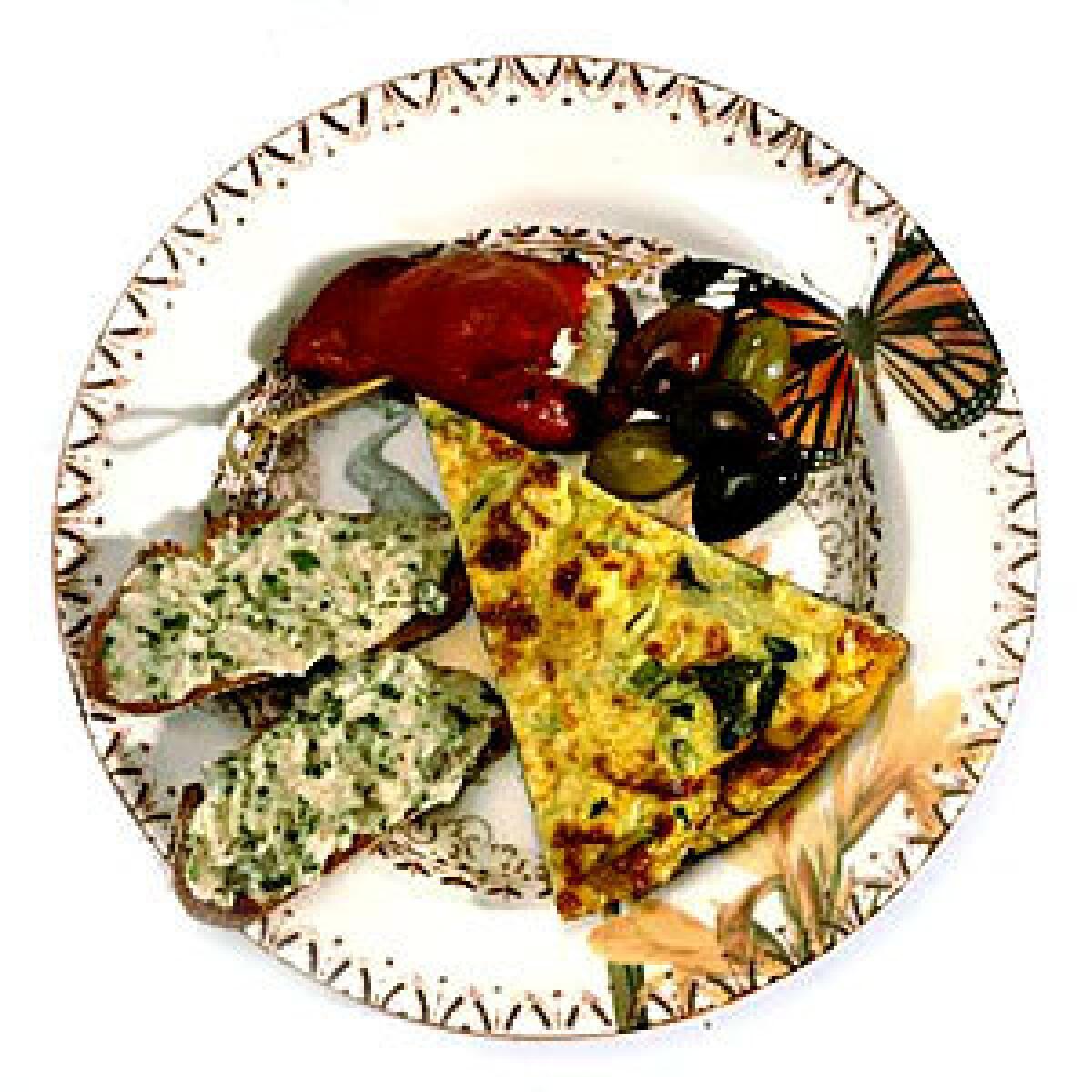Entertaining with an entree-free dinner

You gather with family and friends in the evening as the heat of the day starts to fade and the first cool ocean breezes begin to blow in, thick and sweet as honey. The bright white light of afternoon gradually dims to twilight’s shades of blue and gray. In the air hangs the summer garden smells of baked earth and herbs.
There’s no better time to sit around the backyard to talk a lot and eat just a little.
Let’s face it: Late-summer nights are perfect for entertaining but not so great for cooking or eating three-course meals. This kind of weather calls for a different battle plan for dinner. Rather than a full-frontal attack on hunger, it’s better in summer’s heat to overwhelm the enemy with lots of little bites. And if those dishes can be put together without heating up the kitchen or firing up the grill, so much the better.
If you can toast bread, chop tomatoes and slice some sausage, a small-bites feast is a breeze. Call it antipasti, mezzes or tapas or just plain old appetizers, this spread is the perfect way to eat throughout the evenings of September and early October. Plan a filling dish or two to serve as anchors -- such as a rice salad or a frittata -- then at the last minute assemble an assortment of accompaniments based primarily on staples you have on hand, such as spiced almonds, bruschetta, home-finished olives, stuffed peppers and dried sausages.
Do the real cooking in the cool of the morning, then the only thing you need to do before serving is let the food warm to room temperature.
The menu can be elaborate enough to rival a small tapas bar, or it can be as simple as sliced sausage, spiced almonds, cured olives and a room-temperature frittata.To make a good assortment of small plates, just stock up on some high-quality pantry goods, grab some fresh and seasonal ingredients and master a few basic techniques that can be adapted in a mix-and-match way.
Can you make toast? Good, you’re halfway to bruschetta or crostini (hint: when you’re doing a bunch of toast, it’s easier to bake the bread slices in a 400-degree oven for 15 to 20 minutes). The light but sturdy texture of sourdough works best, but whether it comes from slicing a long, thin baguette or cutting pieces of a round boule is up to you.
So many choices
The list of ideas for toppings is almost endless: marinated fresh cheeses, flavored spreads, chopped tomatoes or vegetables either raw or cooked, little bits of canned anchovies, sardines or tuna. The first step should always be to rub the hot, toasted bread with a cut piece of garlic and then to moisten it slightly with olive oil.
In fact, if you’re planning a big spread with lots of other dishes, you can stop right there. There’s nothing more elegant.
Spiced almonds are another almost-instant appetizer. The classic Spanish technique calls for deep-frying them in olive oil. Nuts cooked this way taste wonderful but are often a little too greasy.
Instead, moisten a cup of raw almonds with just half a teaspoon of good olive oil and stir-fry them in a dry skillet over medium-high heat until they begin to crackle and send up a toasty aroma. This will take only about two or three minutes. Remove them from the heat and sprinkle with salt.
They’re good just like that, but also try flavoring them with a little cumin and a dash of pimentón, the smoked Spanish paprika. Instead of pimentón (or in addition to it), use ground chile. Or toss the almonds with minced, fresh herbs such as sage, rosemary or thyme, or all three.
Every refrigerator should contain a jar of home-finished olives. Take commercially cured black or green brined olives, give them a good rinse and pat them dry. Season them, finishing with a healthy shot of good olive oil, and lemon or orange juice or red wine vinegar. This takes five minutes and makes even canned olives taste like a million bucks. They’ll last for months in the refrigerator; just let them reach room temperature before serving.
Marinade options
Again, this simple technique adapts to variations. Try marinating the olives with different combinations of orange or lemon peel, sliced garlic and spices such as black pepper, cumin, fennel seed or red chiles, as well as fresh herbs such as bay leaves, rosemary, oregano or thyme.
Piquillo red peppers are another canned food that’s handy to have in the pantry. They’re small enough to make perfect bite-sized containers for fresh mozzarella or goat cheese or even canned tuna and mayonnaise.
Arrange the stuffed peppers on a plate and garnish with a drizzle of olive oil and a sprinkling of minced garlic and parsley. Serve them on toasts or spear them with toothpicks so they’ll be easy to handle.
For the meal’s centerpiece, choose rice salads and frittatas, which have the heft of main courses but are light enough to serve as part of a small-bites dinner. Both are almost infinitely variable and can be made in advance and served at cool room temperature.
Making good frittatas takes practice, but once you master the technique, you’ll find yourself cooking them all the time. There are several approaches, but here’s the one that seems to work best: Cook the vegetables just enough to soften. Stir them into beaten eggs along with some grated Parmesan cheese. Pour into a medium-hot nonstick skillet (you can stir the top gently to distribute the ingredients, but not the bottom or you’ll risk sticking).
Reduce the heat to low and cook the eggs slowly until they are almost set. When there is just a thin layer of uncooked egg on top, stick the pan under the broiler just long enough to finish the cooking, and brown the top slightly. Let the frittata cool briefly before removing it from the pan.
You can make a great frittata with shredded zucchini, sauteed onions and red bell peppers, asparagus or mushrooms -- there are so many possibilities.
Rice salads are just as flexible but even easier to make. Here’s a trick: Cook the rice as if it were pasta, in plenty of rapidly boiling water. This way the grains won’t be coated in sticky starch and clump together; they’ll stay light and separate. Cook it a little longer than you might think, because the rice will firm up as it cools.
Dress the warm rice with oil and lemon juice or vinegar because once it cools, its waxy starch hardens and prevents the seasoning from penetrating the grains.
Rice salads can be baroque or simple, made with slivered prosciutto, diced salami, cooked vegetables, pieces of firm cheese, chopped tomatoes and fresh herbs -- just about anything you can think of. To prevent wilting, fold in the raw ingredients right before serving. Taste for salt and vinegar and don’t be shy. Rice is slightly bland, so these salads should be highly seasoned.
Mound the salad in a bowl and surround it with small plates of almonds, sliced salame, olives, bruschetta and more. Make sâure the ice bucket is full of chilled rosé, and put Sarah Vaughan and Astrud Gilberto on shuffle.
Just like that you’re ready for a dozen friends to come over and share a summer evening. Now, how cool is that?
More to Read
Eat your way across L.A.
Get our weekly Tasting Notes newsletter for reviews, news and more.
You may occasionally receive promotional content from the Los Angeles Times.










